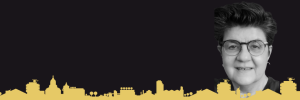
#Researchforimpact: Shaping the ‘last’
When Elizabeth Gunter starts one of her charcoal dust drawings, she imagines how – with charcoal-smeared fingers – she is actually touching her subjects' bodies.
Similarly, when modelling her marble-like sculptures of rhinoceros, elephant or African wild dog foetuses, she imagines her hands touching their delicate little bodies, her fingers encircling their soft shapes.
“I imagine how it would feel to touch them, cuddle them, as it were,'' Gunter, a professor in SU's Department of Visual Arts, explains the process of shaping she follows.
She starts her drawings as hands-on as one can be, without the ever so slight distance between paper and pencil or brush.
First, she lightly dips her fingers into a worn, gold-coloured tin filled with charcoal dust. She then deftly applies the black dust to archival paper in a fluid movement that she refers to as a “humble caress".
Then she reaches for tools, such as a paper stump, pencil and charcoal erasers, or a charcoal stick to create the endangered animals she wants to honour.
Her sculptures start off as lumps of plasticine slowly transformed into animal foetuses. From these silicone moulds, a mixture of materials, including marble dust is used with the sculptures are cast.
The end results seem very realistic, but they are not quite. Having previously studied reference images and skeletons, Gunter draws and sculpts from memory when she imagines her subjects in their pre-birth state as foetuses and, in the case of wild dogs, as fully grown. This gives her work a slight surrealistic or subliminal quality.
“My images are 'imagined' because I rely heavily on long, internalised empathy, knowledge and memory to construe them," she explains.
“When I draw, there are no words," reveals Gunter, who teaches drawing to students.
“This point of wordlessness, made possible through drawing, represents an imagined mutuality with animals, a way of not only understanding their being but also in fact being like them: without speech and spoken language. Drawing allows me to examine notions of 'being animal' and 'becoming animal' because it is so self-reflexive."
Symbolism in her work starts with the charcoal that she favours: “It is burnt wood; wood already dead. By using it, it keeps on living, as I wish these threatened species would continue existing on the planet," she reflects.
Since 2000, her work has dealt with entrenched themes of duality within birth and death, and the violence imbued in the notion that the first step towards death begins with birth.
“Those animals that make their appearance on my drawing paper have never existed before and will only ever exist as imagined animals, not 'real' at all. This is a playful way of 'challenging' or posing dissent to the notion of realism in art."
In 2018, Gunter created her solo exhibition “Last" for the Cavalli Gallery near Stellenbosch. She explored notions around the beginnings and continuance of life as opposed to the end or annihilation thereof, and around the complex bonds that tie the human and non-human animals. The 27 works ranged from tiny white elephant foetuses to be cradled in one's palms to human sized, ghostlike drawings of African wild dogs and vultures. These all address the plight of endangered African animals, a subject that evokes strong emotions in the artist.
On the back of each sculpture, she added numbers to indicate how many individuals of each species are left in the wild, counting each sculptural foetus as a potential, yet only imagined birth beyond the death of the species.
The meaning of “last"
As an intransitive verb, “last" denotes prolongation – for example, of life and of species. As adjective, “last" indicates “being the only remaining", which contrarily would suggest a looming end.
Gunter adds: “In Africa, and particularly in South Africa, the end of several species, some pre-historic in origin, looms ever nearer under the indifferent eye of an apathetic government. As noun, 'last' refers to an implement for shaping leather, intimating a creative act that, while accomplishing protection, adornment, and beauty through shoemaking, requires the cold sacrifice of (animal) life to accomplish mass production."
Gunter concludes: “As such, the bonds between animal and human remain ambiguous and conflictive, enfolding planes of protection, emotion and various forms of intimacy as much as of destruction and distance, while they offer no “last'' answer."
* This article featured in the latest edition of Stellenbosch University (SU)'s multi-award winning publication Research at Stellenbosch University . Produced annually by SU's Division for Research Development (DRD), this flagship publication offers the national and international research community as well as other interested parties a comprehensive, yet accessible overview of innovative and interesting research being done at the institution.The theme of the edition is Research for Impact which is one of SU's core strategic themes from its Vision 2040 and Strategic Framework 2019–2024.
Click here to access the virtual copy.
